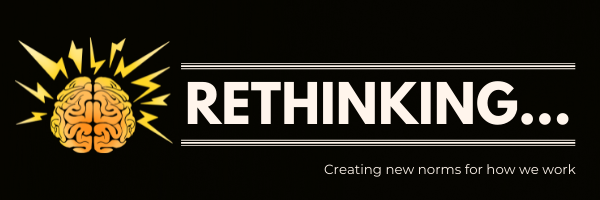
Rethinking…Job Requirements
Rethinking…creating new norms for how we work.
The “Rethinking…” series will explore some of the standard or traditional ways we do our work and why it’s worth rethinking these norms. They are intended to provide healthy food for thought and inspiration for making small steps towards change in how we work.
If you missed the first email in the series, then catch up here: Rethinking…Sacrifice.

Rethinking…Job requirements
You may remember reading a post I wrote last year on my career transition into conservation and the “it’s all about the people” a-ha moment I experienced.
Towards the end of that post, I shared that, “I transitioned out of the Marketing department and into a regional team to work directly with conservation partners around the world to design and implement behavior change campaigns.”
There is also a story behind that story.
Making the internal transition from Marketing Director to Program Manager was not an easy sell to the organization. The “Powers that Be” didn’t see how someone with an advertising background could meet the stated job requirements.
From my perspective, it seemed like a perfect fit as the role and job description mirrored the work I did at ad agencies. The responsibilities and skills focused on partnership management, coaching and training, and a heavy emphasis on project management – all of which I had a lot of experience doing.
The piece I didn’t have was an academic background in conservation biology or natural resource management. For the decision-makers on this transition, this was a deal-breaker that made me unfit for the position.
Yet, there was nothing in the job description that required an academic background in those topics. I would not be collecting or analyzing scientific data, sharing scientific knowledge about the species and habitats of projects, developing environmental interventions, or directly managing natural resources.
The partners we worked with would be responsible for all those pieces.
I ultimately got the position as a “trial run” to see if my assertions about skill alignment were accurate, which came after I put my job on the line in an ultimatum.
That “trial run” turned into the next 15 years of my career of doing similar work of supporting organizations to achieve behavior change goals for conservation outcomes.
Yet, it should not have taken an ultimatum to see that I would be a good fit for the job.
Changing the status quo
While this story is a sample size of one, this pattern of conflating technical skills with transferable skills is more widespread.
I see many job descriptions out there for communication roles, outreach managers, community organizers, program coordinators, and more that require degrees in technical specialties. Some job descriptions even require advanced degrees in those specialties.
And for what purpose?
The daily responsibilities of those jobs rely heavily on transferable skills, like project management, communication, teamwork and partnering abilities, and problem-solving.
Does everyone IN conservation and sustainability need to have a degree IN conservation and sustainability?
Does everyone entering the field need to have an advanced degree or even a college degree?
Oftentimes we add these bullet points to a job description because they’re standard in our templates.
Or, it’s what we came into the job with and, therefore, it’s now an expectation for every future employee who fills the position.
It’s time to rethink the status quo.
Without a doubt, there are positions where advanced degrees are essential. I will not contest that.
But there are also many positions in our organizations that rely more on transferable skills, in which the technical pieces could be learned on the job.
And there are risks to our causes if we don’t rethink our standard job requirements, like leaving out diverse voices, experiences, and perspectives that are critical to developing better ideas, solutions, and outcomes.
This movement is already underway
Rethinking job requirements is a trend that’s currently growing within the corporate and government sectors.
IBM and Accenture – companies that need a high amount of technical expertise in their workforce – have removed the 4-year degree requirement in more than 50% of their job postings.
Check out some of these headlines and quotes on companies removing degree requirements:
Fast Company, For a more equitable recovery, corporations must stop using a college degree as a proxy for ability.
[T]here’s another solution businesses can implement today to support racial equity: address degree inflation in their employment practices. By requiring a bachelor’s degree for jobs that don’t require that level of education experience, employers automatically exclude 76% of Black Americans.
CBS Baltimore, Thousands Of State Jobs No Longer Require A College Degree Under Maryland Initiative.
Maryland Secretary of Labor Tiffany Robinson: “This new career pathway is recognition that expertise, education, responsibility and commitment to excellence can and is developed through many diverse routes.”
New York Times, A 4-Year Degree Isn’t Quite the Job Requirement It Used to Be.
Work force experts see removing the four-year college degree filter for some jobs as key to increasing diversity and reducing inequality. Workers, they say, should be selected and promoted because of their skills and experience rather than degrees or educational pedigree. And companies that do change their hiring practices, they add, benefit by tapping previously overlooked pools of talent in a tight labor market, as well as diversifying their work forces.
If these institutions can do it, nonprofits can too.
Rethinking…training
A key ingredient to rethinking job descriptions is rethinking on-the-job training.
Too many nonprofit organizations adopt a “sink or swim” approach to new hires and do not allocate resources to build employees’ capacities at key stages of their careers.
I get it. Organizations are resource-strapped.
But capacity building doesn’t have to be overly expensive. The main thing it needs to be is prioritized.
Lower cost methods for providing training include:
Online training programs.
Organizations don’t have to develop in-house training programs. Instead, rely on the growing number of online resources that can provide foundational knowledge in technical areas or transferable skills. Here are just a few:
- WildTeam
- NAAEE
- NNOCCI Climate Interpreter course
- Change Wildlife Consumers’ behavior change course
- I’ll include my course here as well. It’s a great training program for employees managing community outreach and behavior change programs.
Peer-to-peer learning.
A benefit of building interdisciplinary teams is that you can coordinate a peer-to-peer learning system so colleagues can learn new skills from one another.
When I became a Program Manager, my colleagues taught me how to use quantitative survey tools like SurveyPro, and, in turn, I shared my skills in conducting qualitative research. It was a wonderful (and fun!) exchange of knowledge.
Mentoring programs for future skills.
In addition to learning the skills needed for the current position, organizations can establish mentoring programs to train employees in the skills needed for their next position.
There are always new skills to learn as one advances through the professional hierarchy and who better to provide that training than the staff members currently in those roles.
Becoming clearer on which job requirements a new hire must have upon entering the organization and which ones can be learned on the job can reshape position descriptions and academic expectations.
One last rethinking note on this topic: It’s time to start listing salary ranges for all job postings. It saves everyone a lot of time when it’s clear what the position pays. Don’t be afraid. Just do it.
Prompts to get you rethinking…
Of the positions currently posted, which ones truly need a college degree or advanced degree to fulfill the responsibilities of the job?
Review the descriptions with a critical eye and assess if relevant work experience is sufficient to do the job. Explore what fears exist that make it difficult to lower the academic barrier to entry.
Which skills can be learned once a new employee has been hired, as opposed to them having it already?
Determine where there is space for new employees to navigate the learning curve on a new topic while on the job and where there isn’t. It’s OK if there are some skills employees must know upon arrival, but be clear on those priorities.
As an organization, create a set of pre-approved courses and training programs employees can choose from that will fill the skill gap.
How can peer-to-peer learning or mentoring be established or expanded in your organization?
Explore opportunities to in-source skill development and leadership training among internal teams. It’s a great arrangement that validates star performers, improves morale, and creates stronger connections across the organization.
Did you list the salary range in your latest job posting?
If not, then do it.


